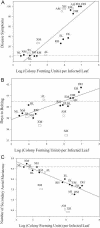A developmental response to pathogen infection in Arabidopsis
- PMID: 12970499
- PMCID: PMC196610
- DOI: 10.1104/pp.103.027094
A developmental response to pathogen infection in Arabidopsis
Abstract
We present evidence that susceptible Arabidopsis plants accelerate their reproductive development and alter their shoot architecture in response to three different pathogen species. We infected 2-week-old Arabidopsis seedlings with two bacterial pathogens, Pseudomonas syringae and Xanthomonas campestris, and an oomycete, Peronospora parasitica. Infection with each of the three pathogens reduced time to flowering and the number of aerial branches on the primary inflorescence. In the absence of competition, P. syringae and P. parasitica infection also increased basal branch development. Flowering time and branch responses were affected by the amount of pathogen present. Large amounts of pathogen caused the most dramatic changes in the number of branches on the primary inflorescence, but small amounts of P. syringae caused the fastest flowering and the production of the most basal branches. RPS2 resistance prevented large changes in development when it prevented visible disease symptoms but not at high pathogen doses and when substantial visible hypersensitive response occurred. These experiments indicate that phylogenetically disparate pathogens cause similar changes in the development of susceptible Arabidopsis. We propose that these changes in flowering time and branch architecture constitute a general developmental response to pathogen infection that may affect tolerance of and/or resistance to disease.
Figures


References
-
- Agnew P, Koella JC, Michalakis Y (2000) Host life history responses to parasitism. Microbes Infect 2: 891-896 - PubMed
-
- Agrios GN (1997) Plant Pathology. Academic Press, San Diego
-
- Beers EP, McDowell JM (2001) Regulation and execution of programmed cell death in response to pathogens, stress and developmental cues. Curr Opin Plant Biol 4: 561-567 - PubMed
-
- Berleth T, Sachs T (2001) Plant morphogenesis: long-distance coordination and local patterning. Curr Opin Plant Biol 4: 57-62 - PubMed
-
- Bradley D, Ratcliffe O, Vincent C, Carpenter R, Coen E (1997) Inflorescence commitment and architecture in Arabidopsis. Science 275: 80-83 - PubMed
Publication types
MeSH terms
Substances
Grants and funding
LinkOut - more resources
Full Text Sources
Molecular Biology Databases
Miscellaneous

